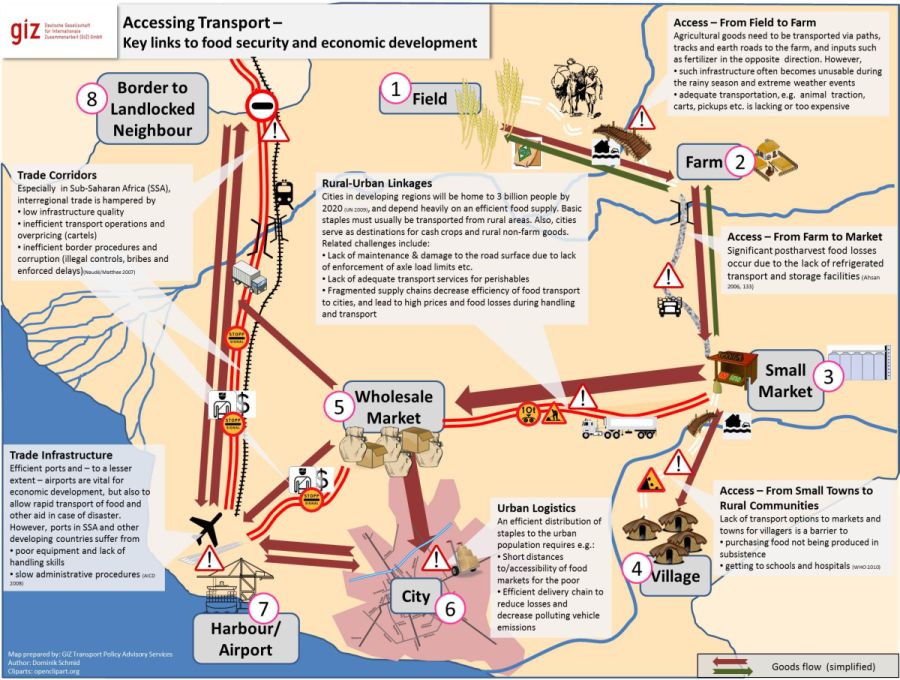Difference between revisions of "Access to Transport"
***** (***** | *****) |
***** (***** | *****) |
||
| Line 1: | Line 1: | ||
| − | |||
= Overview = | = Overview = | ||
| Line 11: | Line 10: | ||
<br/><br/> | <br/><br/> | ||
| + | <br/> | ||
= Challenge: The Lack of Access to Transport = | = Challenge: The Lack of Access to Transport = | ||
| Line 22: | Line 22: | ||
<u>Trade Infrastructure:</u><br/>Average costs for container handling (ship-to-gate) in East Africa are US$135–275, compared to only US$80–154 in the rest of the world (AICD 2008) | <u>Trade Infrastructure:</u><br/>Average costs for container handling (ship-to-gate) in East Africa are US$135–275, compared to only US$80–154 in the rest of the world (AICD 2008) | ||
| − | <u>Trade Corridors:</u><br/>29 % of total transport costs for getting a truck load of onions from Madaoua, Niger to Accra, Ghana are caused by corruption (Bromley et al 2011)<br/>Landlocked countries in Africa may lose the equivalent of up to 40% of the export on high transport costs (Naudé/Matthee 2007)<br/> | + | <u>Trade Corridors:</u><br/>29 % of total transport costs for getting a truck load of onions from Madaoua, Niger to Accra, Ghana are caused by corruption (Bromley et al 2011)<br/>Landlocked countries in Africa may lose the equivalent of up to 40% of the export on high transport costs (Naudé/Matthee 2007)<ref name="Machbarkeitsstudie">Machbarkeitsstudie</ref><br/> |
| + | <br/> | ||
= Mobility and Rural Development = | = Mobility and Rural Development = | ||
| Line 56: | Line 57: | ||
<references /> | <references /> | ||
| + | [[Category:Mobility]] | ||
[[Category:Rural_Development]] | [[Category:Rural_Development]] | ||
| − | |||
Revision as of 09:42, 17 August 2013
Overview
The world trade is growing – regarding its worth and volume: in 2012 more than 150 million containers were sent, in 2011 the worth of goods was about 18 billion US$. However, in many countries the development is hindered by trade: in basic routs in sub-sahara Africa the prices for freighttransport are as double as high as in the EU or USA – because of cartels, bureaucratic obstacles and lacking infrastructure.
Moreover, lacking access to markets due to poor roads in rural areas as well as postharvest losses slow the agricultural productivity with consequences on food security.
At the same time more than 900 million people lack access to all-weather roads what means no access to markets, medicals or schools, especially during rainy seasons.
This article gives an overview about the challenges regarding access to transport in rural areas, its significance and consequences for rural development and the possible approaches of international cooperation on strengthening the access to transport and rural development.[1]
Challenge: The Lack of Access to Transport
The following picture gives an overview about the key links between access to transport and rural economic development and food security.
In the following, a few regional examples for a clearer view:
Access - From Farm to Market:
In India, at least 50% of the production of fruits and vegetables is lost due to wastage and value destruction, with lack of adequate transport being one among the multiple causes. Annual costs estimated at 5 billion US$ .(Ahsan 2006, 133)
Access - From Small Villages to Rural Towns:
More than 900m People worldwide lack access to all-weather roads. The risk of death during giving birth is 36times higher for women in developing countries, not least to the lack of access to medical treatment (WHO 2010)
Trade Infrastructure:
Average costs for container handling (ship-to-gate) in East Africa are US$135–275, compared to only US$80–154 in the rest of the world (AICD 2008)
Trade Corridors:
29 % of total transport costs for getting a truck load of onions from Madaoua, Niger to Accra, Ghana are caused by corruption (Bromley et al 2011)
Landlocked countries in Africa may lose the equivalent of up to 40% of the export on high transport costs (Naudé/Matthee 2007)[1]
Mobility and Rural Development
Economic and social development in rural areas depend on various factors –a very significant one is surely the access to transport infrastructure and transportation services. Without the access to transport an insufficient amount of goods and services is accessible to people as well as agricultural products can't be transported to markets, nor pupils to schools or ill people to hospitals. Moreover, exchange relationsships between rural and urban areas as well as social and political participation depend on an effective transportation system. In this context rural infrastructure and accessibility of local markets as well as interregional linkages of import and export might be considered.
The significance of transport will be explained more thouroughly through the following three articles:
- Access to basic services and mobility of people
- Economic / agricultural perspective
- Hubs and logistics: role of trade
Within the planning process an intensive cooperation between the sectors of transportation and rural development is required. The aspect of financiation not only regarding the construction, but also the maintainance of transport infrastructure might be considered, if mobility should stay a long term development-enhancing factor. Furthermore, the consequences of climate change are of significance for planning and maintaining road infrastructure.
Environment and Security: Negative Sides of Transport Infrastructure
Approaches for Strengthening Rural Development
Further Information




















